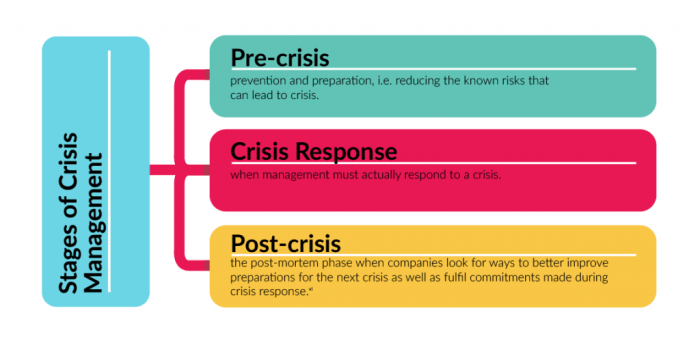Developing a Crisis Management Plan kicks off the journey towards preparedness and resilience, showcasing the importance of strategic planning and effective communication in times of crisis.
This comprehensive guide dives into the key components of a crisis management plan, the significance of a well-prepared crisis management team, communication strategies during turbulent times, and the crucial aspect of evaluating and updating the plan regularly.
Importance of Crisis Management Plan: Developing A Crisis Management Plan

A crisis management plan is crucial for organizations as it provides a structured approach to effectively handle unexpected events that may disrupt normal operations. Without a plan in place, organizations risk facing chaos, confusion, and severe consequences during a crisis.
Real-Life Examples
- During the 2010 BP oil spill in the Gulf of Mexico, BP lacked a comprehensive crisis management plan, resulting in a delayed response and widespread environmental damage. This incident led to massive financial losses and irreparable damage to BP’s reputation.
- In contrast, Johnson & Johnson’s swift and well-executed crisis management plan during the Tylenol poisoning crisis in the 1980s helped them regain public trust and maintain their market share. By recalling products, communicating transparently, and cooperating with authorities, Johnson & Johnson effectively mitigated the crisis.
Consequences of Not Having a Crisis Management Plan
Not having a crisis management plan in place can lead to a range of negative consequences for organizations. These may include prolonged downtime, loss of revenue, damage to reputation, legal liabilities, and even potential closure of the business. Moreover, the lack of a plan can result in disorganized response efforts, ineffective communication, and increased panic among stakeholders.
Key Components of a Crisis Management Plan

In order to effectively navigate through a crisis, a comprehensive crisis management plan should include the following key components:
1. Clear Communication Protocols
Effective communication strategies are essential in a crisis management plan. This includes establishing clear channels of communication, defining roles and responsibilities for communication, and providing regular updates to all stakeholders. For example, utilizing various communication tools such as social media, press releases, and internal memos can help disseminate information quickly and accurately during a crisis.
2. Risk Assessment and Preparedness
Another crucial component is conducting a thorough risk assessment and preparing for potential crises. This involves identifying potential risks, developing response plans for each scenario, and conducting regular drills and exercises to ensure readiness. For instance, creating a detailed risk management matrix can help identify vulnerabilities and prioritize response efforts.
3. Training and Education
Training employees on crisis management procedures is vital for ensuring a swift and coordinated response. This includes conducting regular training sessions, tabletop exercises, and simulations to familiarize staff with their roles and responsibilities during a crisis. Providing employees with the necessary tools and knowledge can help mitigate the impact of a crisis.
4. Leadership and Decision-Making
Strong leadership is essential in implementing and executing a crisis management plan. Leaders should be decisive, calm under pressure, and able to make informed decisions quickly. Establishing a clear chain of command, empowering employees to take action when necessary, and demonstrating effective crisis leadership can help navigate through challenging situations.
Developing a Crisis Management Team
In times of crisis, having a well-prepared crisis management team can make all the difference in effectively handling the situation. Selecting and training the right members for this team is crucial for a successful crisis management plan.
Selecting and Training Team Members
To build a strong crisis management team, individuals with diverse skills and expertise should be chosen. Look for team members who are cool under pressure, excellent communicators, problem-solvers, and quick decision-makers. Training should include providing them with an understanding of the crisis management plan, their specific roles, and how to effectively work together as a team.
Responsibilities and Roles
– Team Leader: Oversees the entire crisis management process and ensures that the plan is executed effectively.
– Communications Coordinator: Manages all internal and external communications during a crisis.
– Subject Matter Experts: Provide specialized knowledge and guidance related to the specific crisis at hand.
– Logistics Coordinator: Handles the practical aspects of crisis response, such as resource allocation and coordination.
– Legal Advisor: Offers legal guidance and ensures that the crisis response is in compliance with regulations.
– Public Relations Officer: Manages the organization’s public image and reputation during the crisis.
Regular Drills and Simulations, Developing a Crisis Management Plan
Regular drills and simulations are essential to test the effectiveness of the crisis management team. These exercises help team members practice their roles, identify any gaps in the plan, and improve coordination and communication among team members. By conducting drills and simulations, the team can be better prepared to handle real crises when they arise.
Communication Strategies during a Crisis
During a crisis, effective communication is crucial to manage the situation and maintain trust with stakeholders. Clear and timely communication can help minimize confusion and prevent misinformation from spreading.
Establishing Communication Channels
- Utilize multiple communication channels such as email, phone, social media, and press releases to reach a wide audience.
- Establish a dedicated crisis communication hotline or website for real-time updates and information dissemination.
- Ensure all communication channels are regularly monitored and updated to provide accurate and consistent information.
Crisis Communication Best Practices
- Provide regular updates to internal stakeholders, such as employees and management, to keep them informed and involved in the crisis response.
- For external stakeholders, be transparent about the situation, share relevant information, and address concerns promptly to maintain trust and credibility.
- Use a spokesperson or designated team to deliver messages consistently across all communication channels for a unified response.
Transparency and Consistency in Communication
- Transparency in communication builds trust and credibility with stakeholders, showing honesty and openness in addressing the crisis.
- Consistent messaging ensures that all stakeholders receive the same information, reducing confusion and preventing conflicting reports.
- Admitting mistakes and taking responsibility in communication can help regain trust and demonstrate a commitment to resolving the crisis effectively.
Evaluating and Updating the Crisis Management Plan
Regularly reviewing and updating a crisis management plan is crucial to ensure its effectiveness in handling unforeseen situations. As the business environment evolves, new risks may emerge, making it essential to adapt and enhance the plan accordingly.
Importance of Regular Review and Update
- Changes in the business environment: With evolving technologies, market trends, and regulations, a crisis management plan must be updated to address new challenges.
- Lessons learned: By reviewing past crises and identifying areas for improvement, organizations can enhance their response strategies and mitigate risks effectively.
- Employee training: Updates to the crisis management plan allow for continuous training of employees, ensuring they are prepared to handle emergencies.
Post-Crisis Evaluations for Improvement
- Conduct a thorough analysis: Evaluate the response to the crisis, identify what worked well, and areas that need improvement.
- Engage stakeholders: Gather feedback from employees, customers, and other relevant parties involved in the crisis response to gain different perspectives.
- Implement changes: Based on the evaluation findings, make necessary updates to the crisis management plan, communication strategies, and team responsibilities.
Lessons Learned from Past Crises
- Communication breakdowns: Following a crisis where communication failures led to confusion, updates were made to establish clear communication protocols and channels.
- Supply chain disruptions: After a crisis exposed vulnerabilities in the supply chain, the crisis management plan was revised to include alternative suppliers and logistics strategies.
- Employee safety concerns: Lessons from a crisis involving employee safety issues prompted the inclusion of detailed safety protocols and training in the updated plan.







